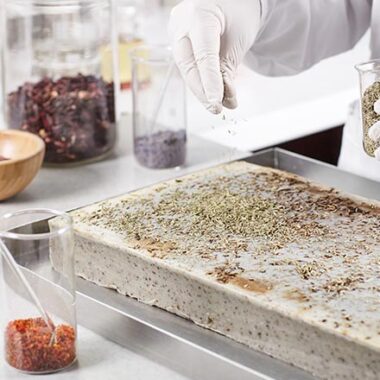When it comes to skincare, knowing what’s in your soap is just as important as how it’s made. Cold process soap is loved for its natural ingredients, gentle formulation, and skin benefits — but what exactly goes into each bar?
In this post, we’ll break down the key ingredients used in cold process soap, what they do for your skin, and why handmade soap is a better alternative to commercial products.
🌿 1. Base Oils and Butters
These are the foundation of any cold process soap recipe, each contributing unique properties to the final bar.
-
Olive Oil: Extremely moisturizing and gentle, ideal for sensitive skin.
-
Coconut Oil: Creates rich lather and cleansing power (used in moderation to avoid dryness).
-
Palm Oil (sustainably sourced): Adds hardness and a creamy texture to soap.
-
Shea Butter: Deeply nourishing, helps with dry and irritated skin.
-
Castor Oil: Boosts lather, making the soap bubbly and luxurious.
-
Sweet Almond Oil / Avocado Oil / Sunflower Oil: Added for extra vitamins and skin conditioning.
.
⚗️ 2. Sodium Hydroxide (Lye)
Sodium hydroxide, also known as lye, is essential for soap making. It may sound harsh, but don’t worry — it’s completely safe when used correctly.
👉 Lye reacts with oils through saponification, creating soap and natural glycerin (a skin-loving humectant).
✅ There is no lye left in the finished product after proper curing.
💧 3. Liquid (Usually Distilled Water)
Water is used to dissolve the lye and start the chemical reaction. Sometimes, soap makers use herbal teas, milk, or aloe vera juice instead of water to add more nutrients and benefits to the soap.
-
Goat Milk: Moisturizing and rich in vitamins
-
Chamomile Tea: Calming for sensitive skin
-
Aloe Vera Juice: Healing and cooling properties
🌸 4. Essential Oils or Natural Fragrances
Cold process soap often uses pure essential oils to scent the bars naturally.
-
Lavender: Calming and floral
-
Peppermint: Invigorating and cooling
-
Tea Tree: Antibacterial and acne-friendly
-
Lemongrass / Orange / Lemon: Uplifting and refreshing
🎨 5. Colorants (Natural or Cosmetic Grade)
Natural soaps can be vibrant or minimalist depending on the colorants used.
-
Clays: Pink clay, French green clay, and bentonite add color and detox benefits
-
Herbs & Botanicals: Turmeric (gold), spirulina (green), activated charcoal (black)
-
Micas: Shimmery, cosmetic-grade powders for bold or artistic designs
🌼 All colorants used in quality cold process soaps are skin-safe and cosmetic-approved.
🌾 6. Additives (for Texture and Skin Benefits)
Add-ins enhance the soap’s appearance, texture, or therapeutic benefits.
-
Dried Flowers: Rose petals, lavender buds, calendula
-
Exfoliants: Oatmeal, coffee grounds, poppy seeds
-
Honey: Natural humectant, adds moisture and softness
-
Aloe Vera Gel: Soothing and healing
-
Charcoal: Detoxifying, especially good for oily or acne-prone skin
💬 Why Ingredients Matter
Choosing soaps made from natural, transparent ingredients means better skin health and fewer irritants. With cold process soap, every component serves a purpose — and every bar tells a story of thoughtful craftsmanship.
🛍️ Final Thoughts
Cold process soap ingredients are simple, pure, and powerful. Unlike commercial soaps loaded with synthetic chemicals, handmade soaps embrace plant-based oils, botanicals, and essential oils that truly care for your skin.
Want to experience the difference?
🌿 Browse our natural cold process soap collection at [YourBrand].com and treat your skin to something real.



